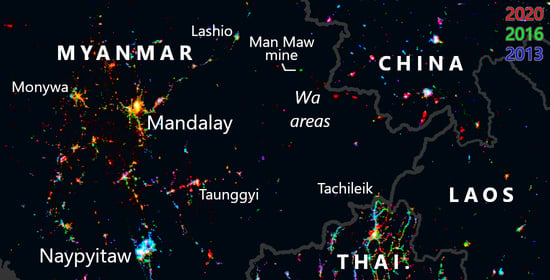Uneven Frontiers: Exposing the Geopolitics of Myanmar’s Borderlands with Critical Remote Sensing
Abstract
1. Introduction
2. Materials and Methods
2.1. Data Collection
2.1.1. Nighttime Light and Geospatial Data
2.1.2. Ethnographic Observations and Secondary Sources
2.2. Methods
2.2.1. Critical Remote Sensing
2.2.2. Data Preprocessing
2.2.3. Data Processing: Univariate Statistical Analysis and Optimized Hot Spot Analysis
3. Results and Discussion
3.1. NTL Dynamics within Myanmar
3.2. NTL Dynamics in Regional Context
3.3. NTL Dynamics in Myanmar’s Borderlands
3.3.1. Northeastern Border with China
3.3.2. Southeastern Border with Thailand
3.3.3. Western Borders with India and Bangladesh
4. Conclusions
Supplementary Materials
Author Contributions
Funding
Institutional Review Board Statement
Informed Consent Statement
Data Availability Statement
Conflicts of Interest
References
- Hu, X.; Qian, Y.; Pickett, S.T.A.; Zhou, W. Urban mapping needs up-to-date approaches to provide diverse perspectives of current urbanization: A novel attempt to map urban areas with nighttime light data. Landsc. Urban Plan. 2020, 195, 103709. [Google Scholar] [CrossRef]
- Zhang, Q.; Seto, K. Can night-time light data identify typologies of urbanization? A global assessment of successes and failures. Remote Sens. 2013, 5, 3476–3494. [Google Scholar] [CrossRef]
- Henderson, M.; Yeh, E.T.; Gong, P.; Elvidge, C.D.; Baugh, K. Validation of urban boundaries derived from global night-time satellite imagery. Int. J. Remote Sens. 2003, 24, 595–609. [Google Scholar] [CrossRef]
- Chen, X.; Nordhaus, W. A test of the new VIIRS lights data set: Population and economic output in Africa. Remote Sens. 2015, 7, 4937–4947. [Google Scholar] [CrossRef]
- Stathakis, D.; Baltas, P. Seasonal population estimates based on night-time lights. Comput. Environ. Urban Syst. 2018, 68, 133–141. [Google Scholar] [CrossRef]
- Min, B.; Gaba, K. Tracking electrification in Vietnam using nighttime lights. Remote Sens. 2014, 6, 9511–9529. [Google Scholar] [CrossRef]
- Falchetta, G.; Pachauri, S.; Parkinson, S.; Byers, E. A high-resolution gridded dataset to assess electrification in sub-Saharan Africa. Sci. Data 2019, 6, 1–9. [Google Scholar] [CrossRef] [PubMed]
- Dugoua, E.; Kennedy, R.; Urpelainen, J. Satellite data for the social sciences: Measuring rural electrification with night-time lights. Int. J. Remote Sens. 2018, 39, 2690–2701. [Google Scholar] [CrossRef]
- Bennett, M.M.; Smith, L.C. Advances in using multitemporal night-time lights satellite imagery to detect, estimate, and monitor socioeconomic dynamics. Remote Sens. Environ. 2017, 192, 176–197. [Google Scholar] [CrossRef]
- Ernst, M.; Jurowetzki, R. Satellite data, women defectors and black markets in North Korea: A quantitative study of the North Korean informal sector using night-time lights satellite imagery. North Korean Rev. 2016, 12, 64–83. [Google Scholar]
- Crespo Cuaresma, J.; Danylo, O.; Fritz, S.; Hofer, M.; Kharas, H.; Laso Bayas, J.C. What do we know about poverty in North Korea? Palgrave Commun. 2020, 6, 1–8. [Google Scholar] [CrossRef]
- Tanaka, K.; Keola, S. Shedding light on the shadow economy: A nighttime light approach. J. Dev. Stud. 2017, 53, 32–48. [Google Scholar] [CrossRef]
- Cauwels, P.; Pestalozzi, N.; Sornette, D. Dynamics and spatial distribution of global nighttime lights. EPJ Data Sci. 2014, 3, 2. [Google Scholar] [CrossRef]
- Kyba, C.C.M.; Garz, S.; Kuechly, H.; Sánchez de Miguel, A.; Zamorano, J.; Fischer, J.; Hölker, F. High-resolution imagery of earth at night: New sources, opportunities and challenges. Remote Sens. 2015, 7, 1–23. [Google Scholar] [CrossRef]
- Zhang, L.; Li, X.; Chen, F. Spatiotemporal analysis of Venezuela’s nighttime light during the socioeconomic crisis. IEEE J. Sel. Top. Appl. Earth Obs. Remote Sens. 2020, 13, 2396–2408. [Google Scholar] [CrossRef]
- Pinkovskiy, M.L. Growth discontinuities at borders. J. Econ. Growth 2017, 22, 145–192. [Google Scholar] [CrossRef]
- Coscieme, L.; Sutton, P.C.; Anderson, S.; Liu, Q.; Elvidge, C.D. Dark times: Nighttime satellite imagery as a detector of regional disparity and the geography of conflict. GISci. Remote Sens. 2017, 54, 118–139. [Google Scholar] [CrossRef]
- United Nations ESCAP. Inequality in Asia and the Pacific in the Era of the 2030 Agenda for Sustainable Development; ESCAP: Bangkok, Thailand, 2018. [Google Scholar]
- Scott, J.C. The Art of Not Being Governed; Yale University Press: London, UK, 2009; ISBN 978-0-300-15228-9. [Google Scholar]
- O’Morchoe, F. Teak & lead: Making borders, resources, and territory in colonial Burma. Geopolitics 2020. [Google Scholar] [CrossRef]
- Sadan, M. Being and Becoming Kachin: Histories Beyond the State in the Borderworlds of Burma; Oxford University Press: Oxford, UK, 2014; ISBN 9780191760341. [Google Scholar]
- Woods, K. Ceasefire capitalism: Military–private partnerships, resource concessions and military–state building in the Burma–China borderlands. J. Peasant Stud. 2011, 38, 747–770. [Google Scholar] [CrossRef]
- Woods, K. Rubber out of the ashes: Locating Chinese agribusiness investments in ‘armed sovereignties’ in the Myanmar–China borderlands. Territ. Polit. Gov. 2019, 7, 79–95. [Google Scholar] [CrossRef]
- Su, X. Fragmented sovereignty and the geopolitics of illicit drugs in northern Burma. Polit. Geogr. 2018, 63, 20–30. [Google Scholar] [CrossRef]
- Meehan, P. Fortifying or fragmenting the state? The political economy of the opium/heroin trade in Shan State, Myanmar, 1988–2013. Crit. Asian Stud. 2015, 47, 253–282. [Google Scholar] [CrossRef]
- Barbesgaard, M. Ocean and land control-grabbing: The political economy of landscape transformation in Northern Tanintharyi, Myanmar. J. Rural Stud. 2019, 69, 195–203. [Google Scholar] [CrossRef]
- Kiik, L. Inter-national conspiracy? Speculating on the Myitsone Dam controversy in China, Burma, Kachin, and a displaced village. Geopolitics 2020, 1–27. [Google Scholar] [CrossRef]
- Mark, S.; Overland, I.; Vakulchuk, R. Sharing the spoils: Winners and losers in the Belt and Road Initiative in Myanmar. J. Curr. Southeast Asian Aff. 2020, 39, 381–404. [Google Scholar] [CrossRef]
- Sarma, J.; Faxon, H.O. Remaking the resource frontier-Insights from Myanmar. Geopolitics 2021. [Google Scholar] [CrossRef]
- Buchanan, J.; Kramer, T.; Woods, K. Developing Disparity: Regional Investment in Burma’s Borderlands; Transnational Institute: Amsterdam, The Netherlands, 2013. [Google Scholar]
- Calabrese, L.; Cao, Y. Managing the Belt and Road: Agency and development in Cambodia and Myanmar. World Dev. 2020, 105297. [Google Scholar] [CrossRef]
- Barua, A.; Karia, R.H. Challenges faced by Rohingya refugees in the Covid-19 pandemic. Ann. Glob. Health 2020, 86, 1–3. [Google Scholar] [CrossRef]
- Torbick, N.; Chowdhury, D.; Salas, W.; Qi, J. Monitoring rice agriculture across Myanmar using time series Sentinel-1 assisted by Landsat-8 and PALSAR-2. Remote Sens. 2017, 9, 119. [Google Scholar] [CrossRef]
- Gumma, M.K.; Thenkabail, P.S.; Deevi, K.C.; Mohammed, I.A.; Teluguntla, P.; Oliphant, A.; Xiong, J.; Aye, T.; Whitbread, A.M. Mapping cropland fallow areas in Myanmar to scale up sustainable intensification of pulse crops in the farming system. GISci. Remote Sens. 2018, 55, 926–949. [Google Scholar] [CrossRef]
- Biswas, S.; Lasko, K.D.; Vadrevu, K.P. Fire disturbance in tropical forests of Myanmar-Analysis using MODIS satellite datasets. IEEE J. Sel. Top. Appl. Earth Obs. Remote Sens. 2015, 8, 2273–2281. [Google Scholar] [CrossRef]
- Hlaing, K.T.; Haruyama, S.; Aye, M.M. Using GIS-based distributed soil loss modeling and morphometric nalysis to prioritize watershed for soil conservation in Bago river basin of Lower Myanmar. Front. Earth Sci. China 2008, 2, 465–478. [Google Scholar] [CrossRef]
- Htun, N.Z.; Mizoue, N.; Yoshida, S. Classifying tropical deciduous vegetation: A comparison of multiple approaches in Popa mountain park, Myanmar. Int. J. Remote Sens. 2011, 32, 8935–8948. [Google Scholar] [CrossRef]
- Food and Agriculture Organization of the United Nations. Global Forest Resources Assessment; FAO: Rome, Italy, 2020. [Google Scholar]
- Leimgruber, P.; Kelly, D.S.; Steininger, M.K.; Brunner, J.; Müller, T.; Songer, M. Forest cover change patterns in Myanmar (Burma) 1990–2000. Environ. Conserv. 2005, 32, 356–364. [Google Scholar] [CrossRef]
- Webb, E.L.; Jachowski, N.R.A.; Phelps, J.; Friess, D.A.; Than, M.M.; Ziegler, A.D. Deforestation in the Ayeyarwady Delta and the conservation implications of an internationally-engaged Myanmar. Glob. Environ. Chang. 2014, 24, 321–333. [Google Scholar] [CrossRef]
- Gaw, L.Y.F.; Linkie, M.; Friess, D.A. Mangrove forest dynamics in Tanintharyi, Myanmar from 1989–2014, and the role of future economic and political developments. Singap. J. Trop. Geogr. 2018, 39, 224–243. [Google Scholar] [CrossRef]
- Biswas, S.; Huang, Q.; Anand, A.; Mon, M.S.; Arnold, F.-E.; Leimgruber, P. A multi sensor approach to forest type mapping for advancing monitoring of sustainable development goals (SDG) in Myanmar. Remote Sens. 2020, 12, 3220. [Google Scholar] [CrossRef]
- Mon, M.S.; Mizoue, N.; Htun, N.Z.; Kajisa, T.; Yoshida, S. Factors affecting deforestation and forest degradation in selectively logged production forest: A case study in Myanmar. For. Ecol. Manag. 2012, 267, 190–198. [Google Scholar] [CrossRef]
- Shimizu, K.; Ponce-Hernandez, R.; Ahmed, O.S.; Ota, T.; Win, Z.C.; Mizoue, N.; Yoshida, S. Using Landsat time series imagery to detect forest disturbance in selectively logged tropical forests in Myanmar. Can. J. For. Res. 2017, 47, 289–296. [Google Scholar] [CrossRef]
- Reddy, C.S.; Pasha, S.V.; Satish, K.V.; Unnikrishnan, A.; Chavan, S.B.; Jha, C.S.; Diwakar, P.G.; Dadhwal, V.K. Quantifying and predicting multi-decadal forest cover changes in Myanmar: A biodiversity hotspot under threat. Biodivers. Conserv. 2019, 28, 1129–1149. [Google Scholar] [CrossRef]
- Win, R.N.; Suzuki, R.; Takeda, S. Remote sensing analysis of forest damage by selection logging in the Kabaung Reserved Forest, Bago Mountains, Myanmar. J. For. Res. 2012, 17, 121–128. [Google Scholar] [CrossRef]
- Htun, N.Z.; Mizoue, N.; Kajisa, T.; Yoshida, S. Deforestation and forest degradation as measures of Popa Mountain Park (Myanmar) effectiveness. Environ. Conserv. 2009, 36, 218–224. [Google Scholar] [CrossRef]
- Sharma, P.; Thapa, R.B.; Matin, M.A. Examining forest cover change and deforestation drivers in Taunggyi District, Shan State, Myanmar. Environ. Dev. Sustain. 2020, 22, 5521–5538. [Google Scholar] [CrossRef]
- Wang, C.; Myint, S.W. Environmental concerns of deforestation in Myanmar 2001–2010. Remote Sens. 2016, 8, 728. [Google Scholar] [CrossRef]
- Tian, Y.; Wu, B.; Zhang, L.; Li, Q.; Jia, K.; Wen, M. Opium poppy monitoring with remote sensing in north Myanmar. Int. J. Drug Policy 2011, 22, 278–284. [Google Scholar] [CrossRef]
- Kelly, A.B.; Kelly, N.M. Validating the remotely sensed geography of crime: A review of emerging issues. Remote Sens. 2014, 6, 12723–12751. [Google Scholar] [CrossRef]
- Baker, J.C.; Williamson, R.A. Satellite imagery activism: Sharpening the focus on tropical deforestation. Singap. J. Trop. Geogr. 2006, 27, 4–14. [Google Scholar] [CrossRef]
- Rothe, D.; Shim, D. Sensing the ground: On the global politics of satellite-based activism. Rev. Int. Stud. 2018, 44, 414–437. [Google Scholar] [CrossRef]
- Marx, A.; Windisch, R.; Kim, J.S. Detecting village burnings with high-cadence smallsats: A case-study in the Rakhine State of Myanmar. Remote Sens. Appl. Soc. Environ. 2019, 14, 119–125. [Google Scholar] [CrossRef]
- Bremner, L. Sedimentary logics and the Rohingya refugee camps in Bangladesh. Polit. Geogr. 2020, 77, 102109. [Google Scholar] [CrossRef]
- Ruser, B.N.; Thomas, E. Mapping Conditions in Rakhine State; Australian Strategic Policy Institute: Canberra, Australia, 2019. [Google Scholar]
- Ahmed, N.; Diptu, N.A.; Shadhin, M.S.K.; Jaki, M.A.F.; Hasan, M.F.; Islam, M.N.; Rahman, R.M. Artificial neural network and machine learning based methods for population estimation of Rohingya refugees: Comparing data-driven and satellite image-driven approaches. Vietnam J. Comput. Sci. 2019, 6, 439–455. [Google Scholar] [CrossRef]
- Imtiaz, S. Ecological impact of Rohingya refugees on forest resources: Remote sensing analysis of vegetation cover change in Teknaf Peninsula in Bangladesh. Ecocycles 2018, 4, 16–19. [Google Scholar] [CrossRef]
- Rashid, K.J.; Hoque, M.A.; Esha, T.A.; Rahman, M.A.; Paul, A. Spatiotemporal changes of vegetation and land surface temperature in the refugee camps and its surrounding areas of Bangladesh after the Rohingya influx from Myanmar. Environ. Dev. Sustain. 2020. [Google Scholar] [CrossRef]
- Hassan, M.; Smith, A.; Walker, K.; Rahman, M.; Southworth, J. Rohingya refugee crisis and forest cover change in Teknaf, Bangladesh. Remote Sens. 2018, 10, 689. [Google Scholar] [CrossRef]
- Connette, K.J.L.J.; Connette, G.; Bernd, A.; Phyo, P.; Aung, K.H.; Tun, Y.L.; Thein, Z.M.; Horning, N.; Leimgruber, P.; Songer, M. Assessment of mining extent and expansion in Myanmar based on freely-available satellite imagery. Remote Sens. 2016, 8, 912. [Google Scholar] [CrossRef]
- Poortinga, A.; Tenneson, K.; Shapiro, A.; Nquyen, Q.; Aung, K.S.; Chishtie, F.; Saah, D. Mapping plantations in Myanmar by fusing Landsat-8, Sentinel-2 and Sentinel-1 data along with systematic error quantification. Remote Sens. 2019, 11, 831. [Google Scholar] [CrossRef]
- Nomura, K.; Mitchard, E.T.A.; Patenaude, G.; Bastide, J.; Oswald, P.; Nwe, T. Oil palm concessions in southern Myanmar consist mostly of unconverted forest. Sci. Rep. 2019, 9, 1–9. [Google Scholar] [CrossRef] [PubMed]
- Liu, X.; Feng, Z.; Jiang, L.; Li, P.; Liao, C.; Yang, Y.; You, Z. Rubber plantation and its relationship with topographical factors in the border region of China, Laos and Myanmar. J. Geogr. Sci. 2013, 23, 1019–1040. [Google Scholar] [CrossRef]
- Aung, T.S.; Fischer, T.B.; Buchanan, J. Land use and land cover changes along the China-Myanmar oil and gas pipelines–Monitoring infrastructure development in remote conflict-prone regions. PLoS ONE 2020, 15, e0237806. [Google Scholar] [CrossRef]
- Tellman, B.; Magliocca, N.R.; Turner, B.L.; Verburg, P.H. Understanding the role of illicit transactions in land-change dynamics. Nat. Sustain. 2020, 3, 175–181. [Google Scholar] [CrossRef]
- Puttanapong, N.; Zin, S.Z. Spatial inequality in Myanmar during 1992–2016: An application of spatial statistics and satellite data. Soc. Sci. Rev. 2018, 161–182. [Google Scholar]
- Callahan, M. Myanmar’s Perpetual Junta. New Left Rev. 2009, 60, 27–63. [Google Scholar]
- Jones, L. The political economy of Myanmar’s transition. J. Contemp. Asia 2014, 44, 144–170. [Google Scholar] [CrossRef]
- Ahmed, N.; Islam, M.N.; Hasan, M.F.; Motahar, T.; Sujauddin, M. Understanding the political ecology of forced migration and deforestation through a multi-algorithm classification approach: The case of Rohingya displacement in the southeastern border region of Bangladesh. Geol. Ecol. Landsc. 2019, 3, 282–294. [Google Scholar] [CrossRef]
- Bennett, M.M. Is a pixel worth 1000 words? Critical remote sensing and China’s belt and road initiative. Polit. Geogr. 2020, 78, 102127. [Google Scholar] [CrossRef]
- Faxon, H.O. After the rice frontier: Producing state and ethnic territory in Northwest Myanmar. Geopolitics 2021, 1–25. [Google Scholar] [CrossRef]
- Grundy-Warr, C. Coexistent borderlands and intra-state conflicts in mainland Southeast Asia. Singap. J. Trop. Geogr. 1993, 14, 42–57. [Google Scholar] [CrossRef]
- Barney, K. Laos and the making of a ‘relational’ resource frontier. Geogr. J. 2009, 175, 146–159. [Google Scholar] [CrossRef]
- Giersch, C.P. Across Zomia with merchants, monks, and musk: Process geographies, trade networks, and the Inner-East-Southeast Asian borderlands. J. Glob. Hist. 2010, 5, 215–239. [Google Scholar] [CrossRef]
- Li, X.; Zhou, Y.; Zhao, M.; Zhao, X. A harmonized global nighttime light dataset 1992–2018. Sci. Data 2020, 7, 1–9. [Google Scholar] [CrossRef]
- Elvidge, C.D.; Zhizhin, M.; Ghosh, T.; Hsu, F.; Taneja, J. Annual time series of global VIIRS nighttime lights derived from monthly averages: 2012 to 2019. Remote Sens. 2021, 13, 922. [Google Scholar] [CrossRef]
- Elvidge, C.D.; Baugh, K.; Zhizhin, M.; Hsu, F.C. Why VIIRS data are superior to DMSP for mapping nighttime lights. Proc. Asia-Pac. Adv. Netw. 2013, 62–69. [Google Scholar] [CrossRef]
- Puttilli, M. Everyday geographies in the changing city: Subjective photo-routes in Mandalay, Myanmar. GeoJournal 2020, 8. [Google Scholar] [CrossRef]
- Kudo, T. Border development in Myanmar: The case of the Myawaddy–Mae Sot border. In Border Economies in the Greater Mekong Sub-Region; Ishida, M., Ed.; Palgrave Macmillan UK: London, UK, 2013; pp. 186–205. [Google Scholar]
- Alvarez León, L.F.; Gleason, C.J. Production, property, and the construction of remotely sensed data. Ann. Am. Assoc. Geogr. 2017, 107, 1075–1089. [Google Scholar] [CrossRef]
- Devine, J.A.; Currit, N.; Reygadas, Y.; Liller, L.I.; Allen, G. Drug trafficking, cattle ranching and land use and land cover change in Guatemala’s Maya biosphere reserve. Land Use Policy 2020, 95, 104578. [Google Scholar] [CrossRef]
- Devine, J.A.; Wrathall, D.; Currit, N.; Tellman, B.; Langarica, Y.R. Narco-cattle ranching in political forests. Antipode 2020, 52, 1018–1038. [Google Scholar] [CrossRef]
- Kelley, L.C. The politics of uneven smallholder cacao expansion: A critical physical geography of agricultural transformation in southeast Sulawesi, Indonesia. Geoforum 2018, 97, 22–34. [Google Scholar] [CrossRef]
- Biermann, C.; Kelley, L.C.; Lave, R. Putting the Anthropocene into practice: Methodological implications. Ann. Am. Assoc. Geogr. 2020, 1–11. [Google Scholar] [CrossRef]
- Saah, D.; Johnson, G.; Ashmall, B.; Tondapu, G.; Tenneson, K.; Patterson, M.; Poortinga, A.; Markert, K.; Quyen, N.H.; San Aung, K.; et al. Collect Earth: An online tool for systematic reference data collection in land cover and use applications. Environ. Model. Softw. 2019, 118, 166–171. [Google Scholar] [CrossRef]
- Oak, Y.N. Even with New Data, Valuing Myanmar’s Jade Industry Remains a Challenge. Open Data: Myanmar Jade; Natural Resource Governance Institute n.d. Available online: https://openjadedata.org/Stories/how_much_jade_worth.html (accessed on 17 March 2021).
- Kyba, C.C.M.; Giuliani, G.; Franziskakis, F.; Tockner, K.; Lacroix, P. Artisanal and small-scale mining sites in the Democratic Republic of the Congo are not associated with nighttime light emissions. J Multidiscip. Sci. J. 2019, 2, 152–161. [Google Scholar] [CrossRef]
- Matelski, M.; Sabrié, M. Challenges and resilience in Myanmar’s urbanization: A special issue on Yangon. Moussons 2019, 11–31. [Google Scholar] [CrossRef]
- Walton, M.J. The “Wages of Burman-ness:” Ethnicity and Burman privilege in contemporary Myanmar. J. Contemp. Asia 2013, 43, 1–27. [Google Scholar] [CrossRef]
- Sarma, J.; Sidaway, J.D. Securing urban fontiers: A view from Yangon, Myanmar. Int. J. Urban Reg. Res. 2020, 44, 447–468. [Google Scholar] [CrossRef]
- Kennard, M.; Provost, C. The Lights Are on but no One’s Home in Myanmar’s Capital Naypyidaw. South China Morning Post. 4 April 2015. Available online: https://www.scmp.com/magazines/post-magazine/article/1755128/lights-are-no-ones-home-myanmars-new-capital-naypyidaw (accessed on 17 March 2021).
- Myanmar Ministry of Commerce. Trade Situation of Myanmar in 2012–2013 Fiscal Year to 2020–2021 Fiscal Year (October Monthly). 2021. Available online: https://www.commerce.gov.mm/en/content/ပံုုမွန္-နယ္စပ္-ပိုု႔ကုုန္-သြင္းကုုန္ (accessed on 10 January 2021).
- Republic of Myanmar Directorate of Investment and Company Administration. Yearly Approved Amount of Investment (By Country/Region) 2020. Available online: https://www.dica.gov.mm/sites/dica.gov.mm/files/document-files/yearly_country_11.pdf (accessed on 10 January 2021).
- Lwin, N. Myanmar Govt Unveils Four Projects as Part of China’s BRI Scheme. The Irrawaddy. 14 June 2020. Available online: https://www.irrawaddy.com/news/burma/myanmar-govt-unveils-four-projects-part-chinas-bri-scheme.html (accessed on 17 March 2021).
- Myanmar Ministry of Commerce. Border Trade Data. Available online: https://www.commerce.gov.mm/en/dobt/border-trade-data (accessed on 7 January 2021).
- Chang, W.-C. Beyond Borders: Stories of Yunnanese Chinese Migrants of Burma; Cornell University Press: Ithaca, NY, USA, 2016. [Google Scholar]
- Shortell, P. Losing Luster: Addressing Tax Evasion in Myanmar’s Jade and Gemstone Industry; Natural Resource Governance Institute: New York, NY, USA, 2019. [Google Scholar]
- Lintner, B. Who Are the Wa? The Irrawaddy. 2 June 2014. Available online: https://www.irrawaddy.com/news/military/wa.html (accessed on 17 March 2021).
- Nijman, V.; Shepherd, C.R. Emergence of Mong La on the Myanmar-China border as a global hub for the international trade in ivory and elephant parts. Biol. Conserv. 2014, 179, 17–22. [Google Scholar] [CrossRef]
- Rippa, A.; Saxer, M. Mong La: Business as usual in the China-Myanmar borderlands. Cross-Curr. East Asian Hist. Cult. Rev. 2016, 19, 240–252. [Google Scholar]
- Than, T. Mongla and the borderland politics of Myanmar. Asian Anthropol. 2016, 15, 152–168. [Google Scholar] [CrossRef]
- Fiskesjö, M. Mining, history, and the anti-state Wa: The politics of autonomy between Burma and China. J. Glob. Hist. 2010, 5, 241–264. [Google Scholar] [CrossRef]
- James, H. Security and sustainable development in Myanmar. Secur. Sustain. Dev. Myanmar 2006, 1–231. [Google Scholar] [CrossRef]
- United Nations Office on Drugs and Crime. Sustaining Opium Reduction in Southeast Asia: Sharing Experiences on Alternative Development and Beyond; UNODC: Washington, DC, USA, 2008. [Google Scholar]
- Ong, A.; Steinmüller, H. Communities of care: Public donations, development assistance, and independent philanthropy in the Wa State of Myanmar. Crit. Anthropol. 2020. [Google Scholar] [CrossRef]
- Inkey, M. UWSA Forcibly Relocate Mountain Dwelling Ethnic Wa to the Plains. Burma News International. 9 January 2015. Available online: https://www.bnionline.net/en/shan-herald-agency-for-news/item/18030-uwsa-forcibly-relocate-mountain-dwelling-ethnic-wa-to-the-plains.html (accessed on 17 March 2021).
- Heimig, C.; Schutte, P.; Franken, G.; Klein, C. Tin from Myanmar: A scenario for applying the European Union Regulation on supply chain due diligence. Commod. TopNews 2019, 61, 1–13. [Google Scholar]
- Gardiner, N.J.; Sykes, J.P.; Trench, A.; Robb, L.J. Tin mining in Myanmar: Production and potential. Resour. Policy 2015, 46, 219–233. [Google Scholar] [CrossRef]
- Lee, Y.; Slowkowski, A. Exclusive: Production Slowing Fast at Myanmar Mine that Rattled Tin Market. Reuters. 19 October 2016. Available online: https://www.reuters.com/article/us-myanmar-wa-tin-exclsuive/exclusive-production-slowing-fast-at-myanmar-mine-that-rattled-tin-market-idUSKCN12J02F (accessed on 18 March 2021).
- Bauer, A.; Kirk, N.; Sahla, S. Natural Resource Federalism: Considerations for Myanmar; Natural Resource Governance Institute: New York, NY, USA, 2018. [Google Scholar]
- Ong, A. Producing intransigence: (Mis) understanding the United Wa State Army in Myanmar. Contemp. Southeast Asia 2018, 40, 449–474. [Google Scholar] [CrossRef]
- May, S.Y. Migration as a Challenge for Myanmar’s Socio-Economic Development: Case Studies of Hpa-an and Mrauk-U Townships in Myanmar, Proceedings of the International Conference on Burma/Myanmar Studies, Chiang Mai, Thailand, 24–26 July 2015; University Academic Service Centre, Chiang Mai University: Chiang Mai, Thailand, 2015; pp. 1–14. [Google Scholar]
- Campbell, S. Border Capitalism, Disrupted; Cornell University Press: Ithaca, NY, USA, 2018. [Google Scholar]
- Naing, Y.Y.; Chulasai, L.; Panthamit, N. Characteristics of cross border trade in Myawaddy Township, Kayin State, Myanmar. C. J. Econ. 2010, 14, 100–122. [Google Scholar]
- Grundy-Warr, C.; Yin, E.W.S. Geographies of displacement: The Karenni and the Shan across the Myanmar-Thailand border. Singap. J. Trop. Geogr. 2002, 23, 93–122. [Google Scholar] [CrossRef]
- Mahadevan, P. Crossing the Line: Geopolitics and Criminality at the India-Myanmar Border; Global Initiative against Transnational Organized Crime: Geneva, Switzerland, 2020. [Google Scholar]
- Bana, N.; Yhome, K. The Road to Mekong: The India-Myanmar-Thailand Trilateral Highway Project. ORF Issue Br. 2017, 171, 1–12. [Google Scholar]
- Vicol, M.; Pritchard, B.; Htay, Y.Y. Rethinking the role of agriculture as a driver of social and economic transformation in Southeast Asia’s upland regions: The view from Chin State, Myanmar. Land Use Policy 2018, 72, 451–460. [Google Scholar] [CrossRef]
- Milton, A.; Rahman, M.; Hussain, S.; Jindal, C.; Choudhury, S.; Akter, S.; Ferdousi, S.; Mouly, T.; Hall, J.; Efird, J. Trapped in Statelessness: Rohingya refugees in Bangladesh. Int. J. Environ. Res. Public Health 2017, 14, 942. [Google Scholar] [CrossRef]
- Vince, G. The world’s largest refugee camp prepares for Covid-19. BMJ 2020, 368, 2–3. [Google Scholar] [CrossRef]
- Cheesman, N. How in Myanmar “National Races” came to surpass citizenship and exclude Rohingya. J. Contemp. Asia 2017, 47, 461–483. [Google Scholar] [CrossRef]
- World Bank. Access to Electricity (% of Population)-Myanmar. 2021. Available online: https://data.worldbank.org/indicator/EG.ELC.ACCS.ZS?locations=MM (accessed on 10 January 2021).
- Human Rights Watch. Massacre by the River: Burmese Army Crimes against Humanity in Tula Toli, 19 December 2017; ISBN 978-1-6231-35614.
- Jendryke, M.; Balz, T.; McClure, S.C.; Liao, M. Putting people in the picture: Combining big location-based social media data and remote sensing imagery for enhanced contextual urban information in Shanghai. Comput. Environ. Urban Syst. 2017, 62, 99–112. [Google Scholar] [CrossRef]
- Earth Observation Group. DMSP Nighttime Lights Extension. 2021. Available online: https://eogdata.mines.edu/products/dmsp/#extend (accessed on 7 March 2021).
- Goldstein, J.E.; Faxon, H.O. New data infrastructures for environmental monitoring in Myanmar: Is digital transparency good for governance? Environ. Plan. E Nat. Space 2020. [Google Scholar] [CrossRef]
- Gabor, D.; Brooks, S. The digital revolution in financial inclusion: International development in the fintech era. New Polit. Econ. 2017, 22, 423–436. [Google Scholar] [CrossRef]
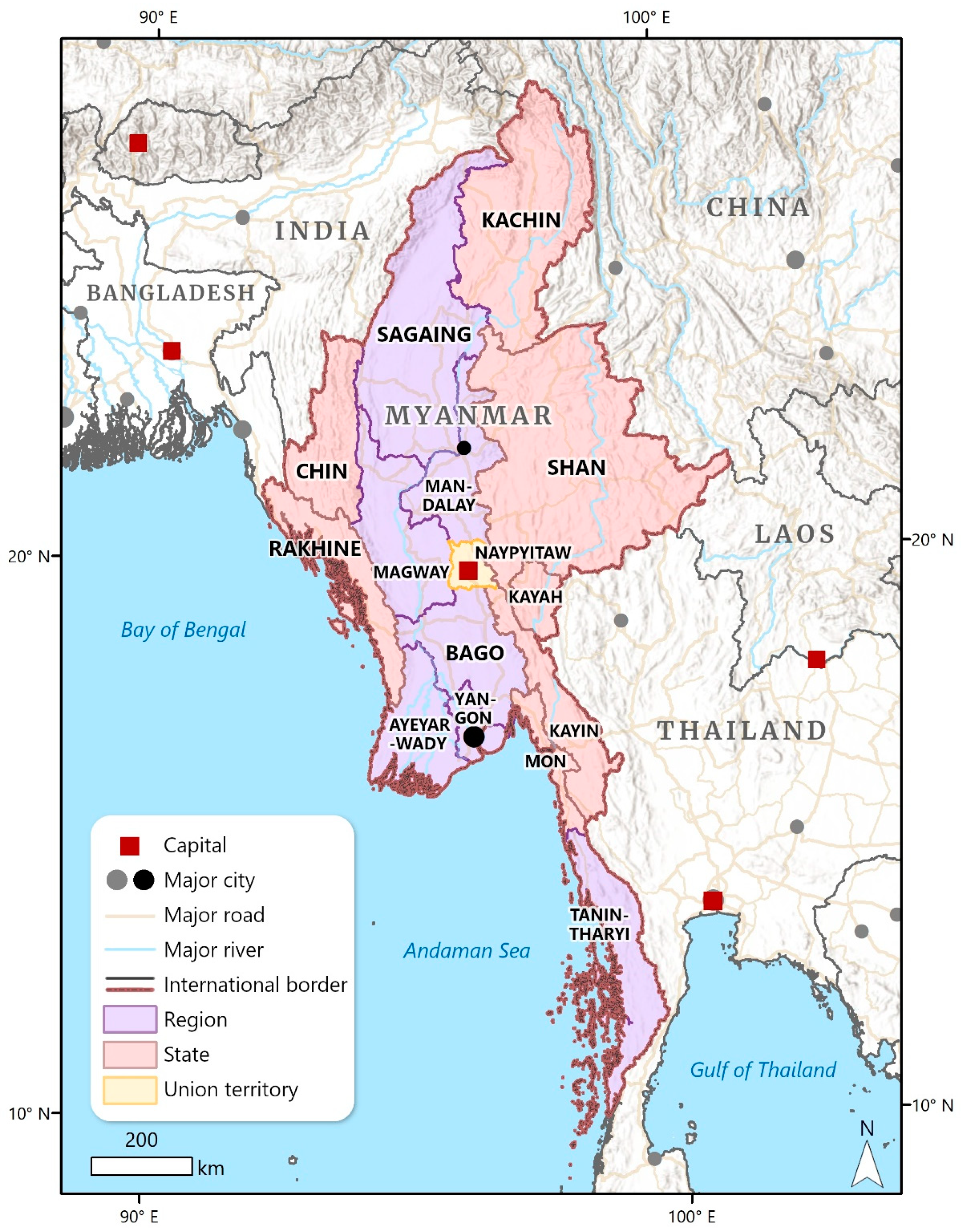
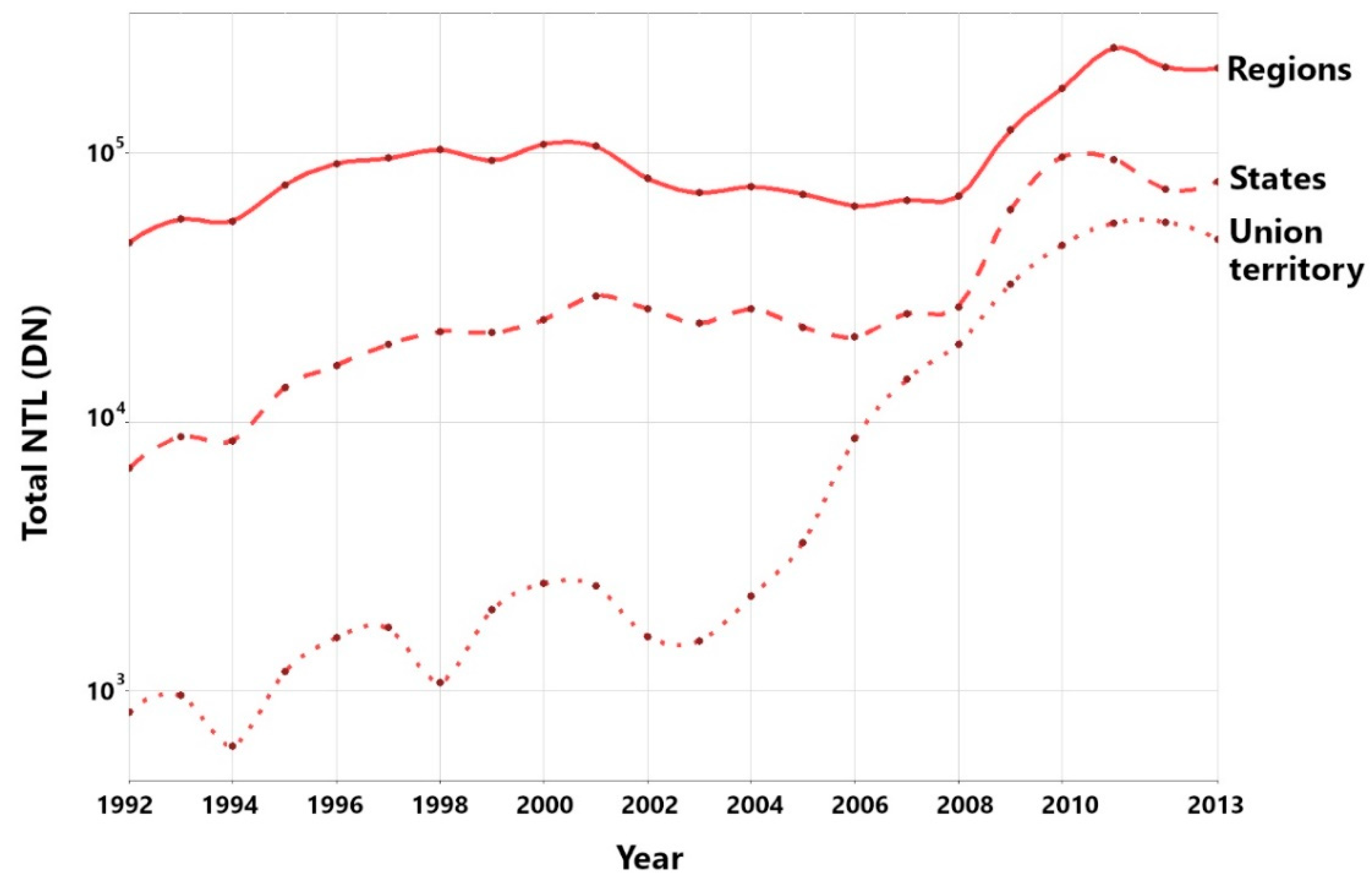

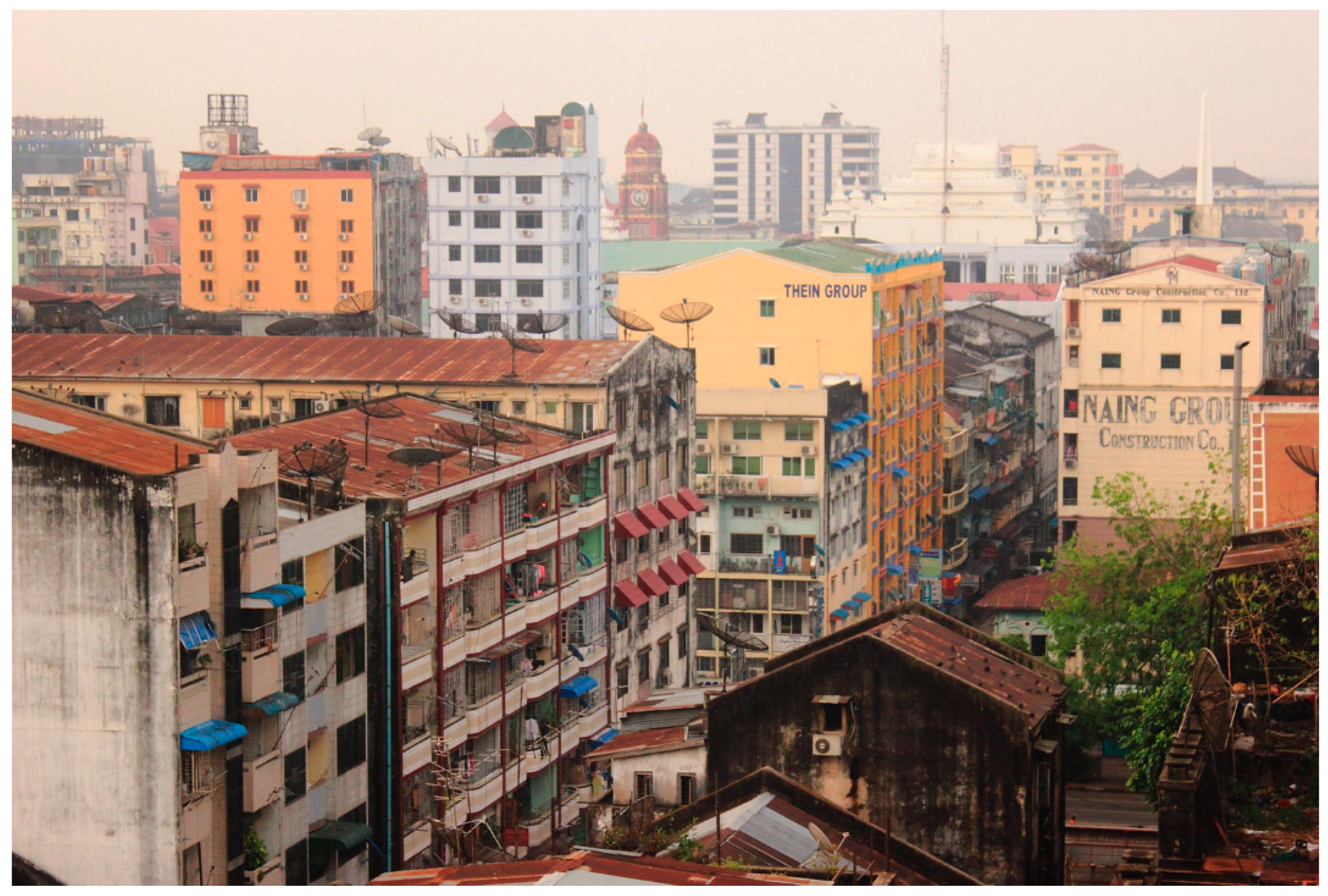
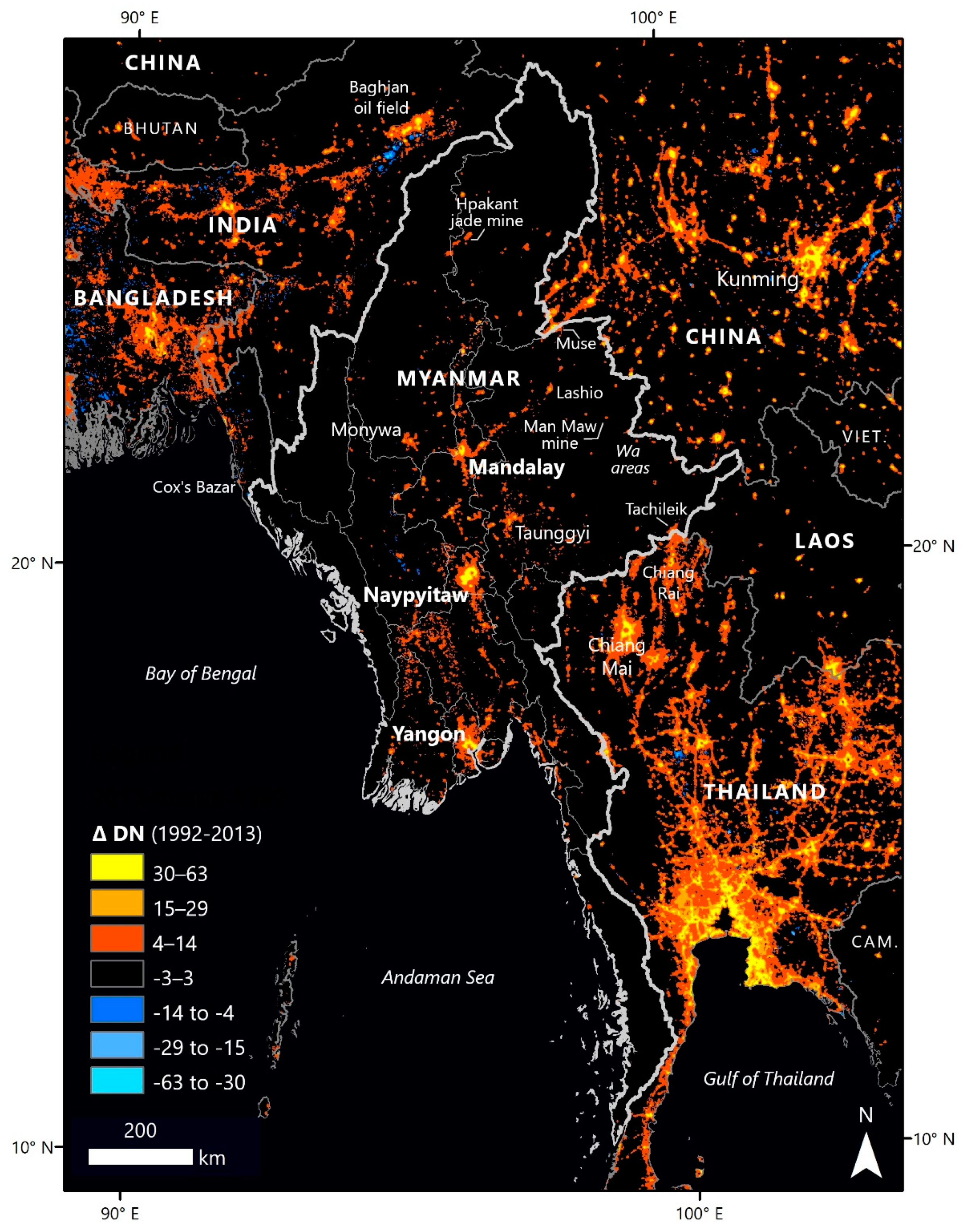
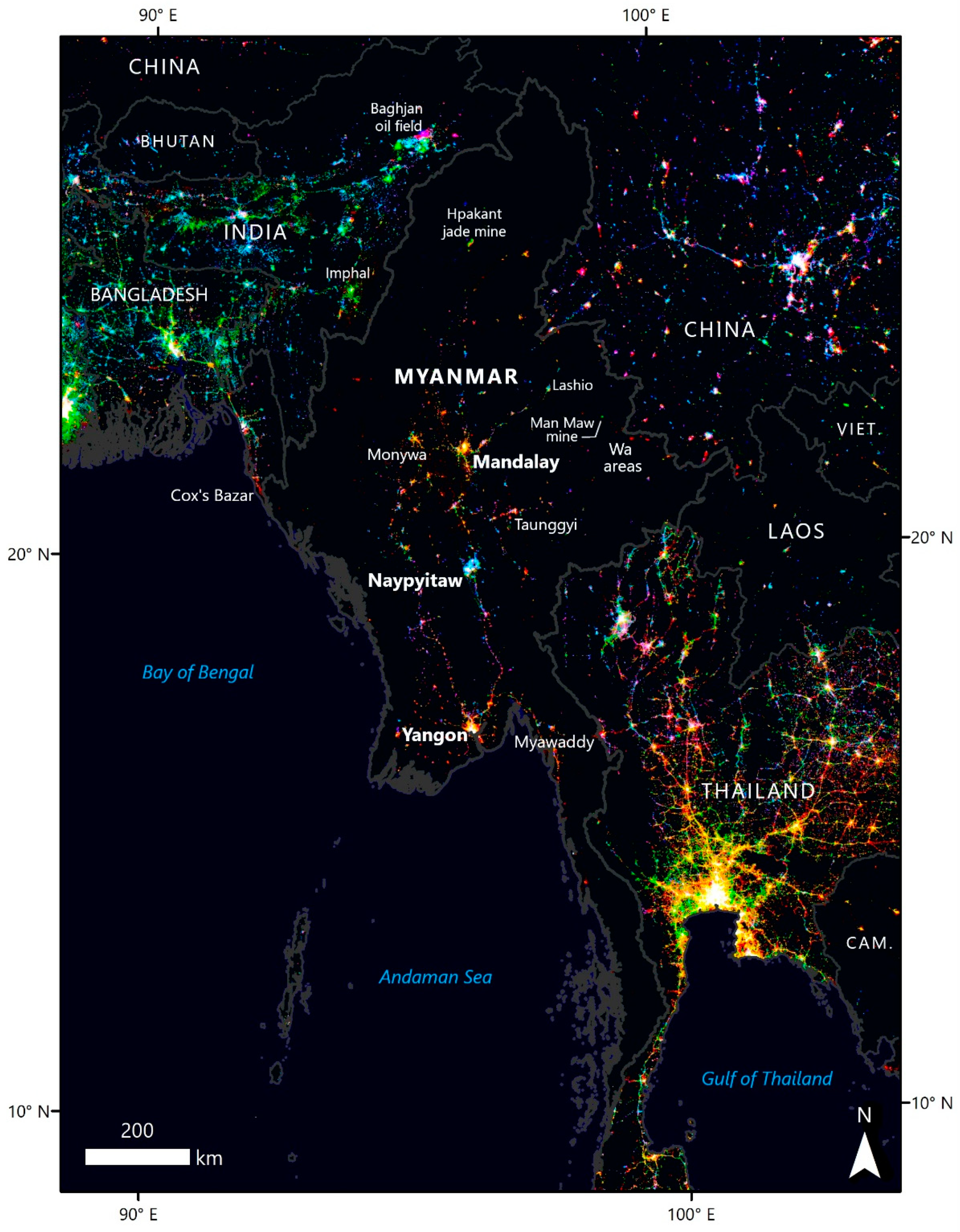
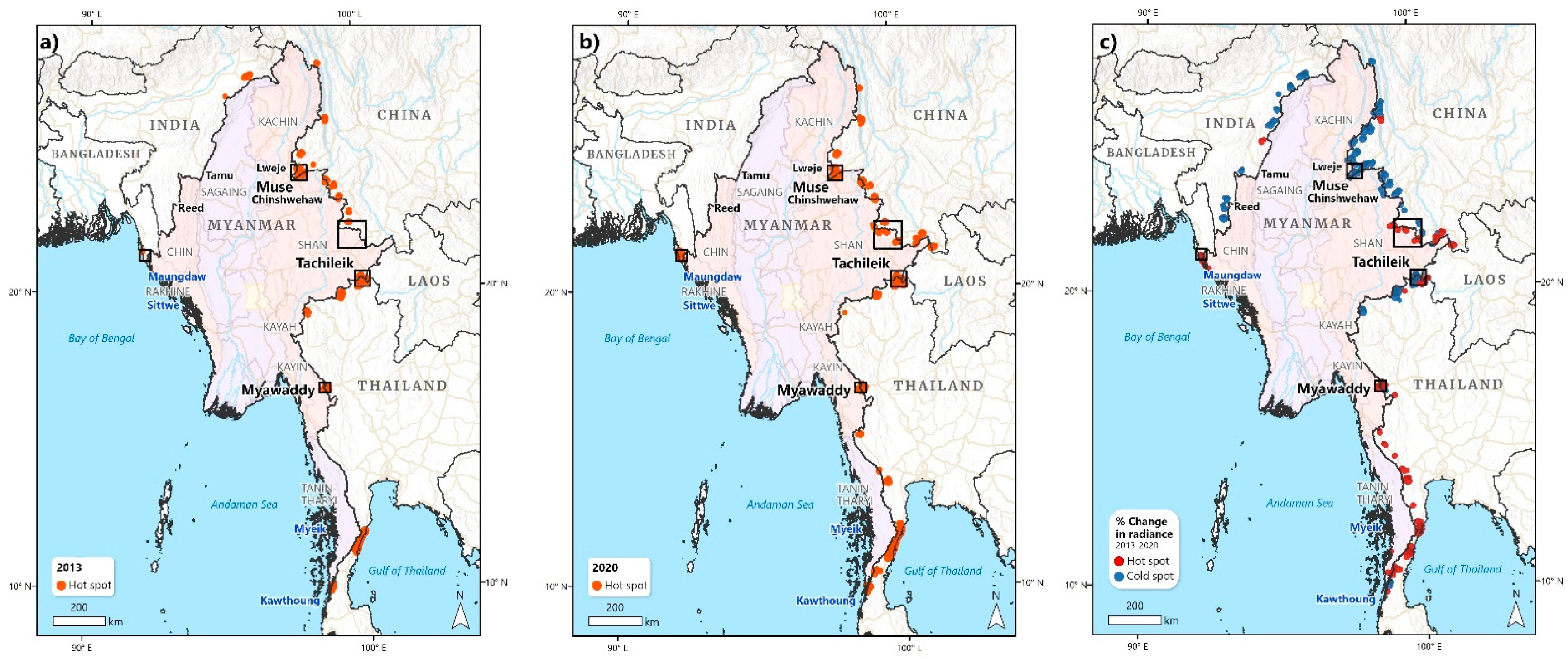
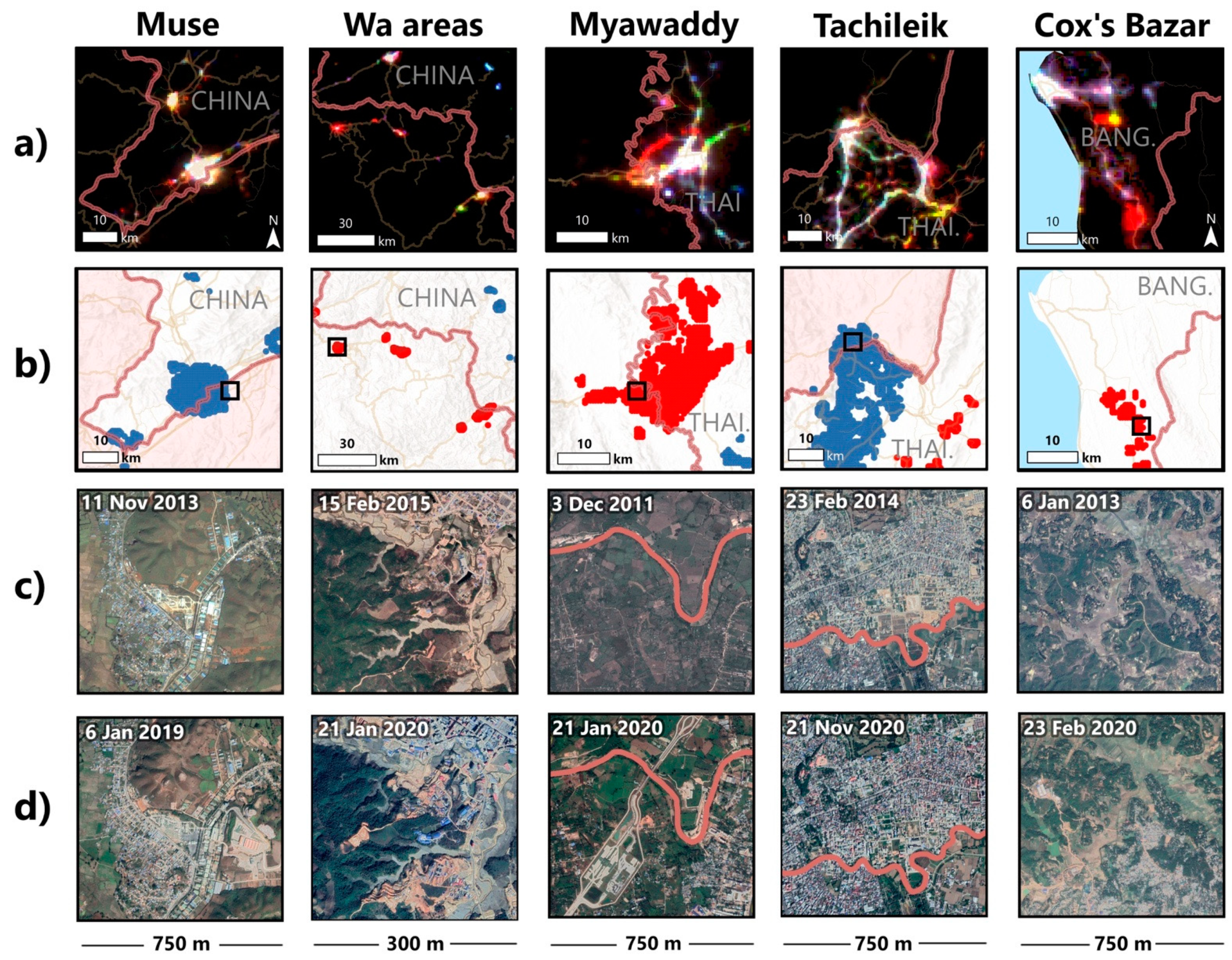
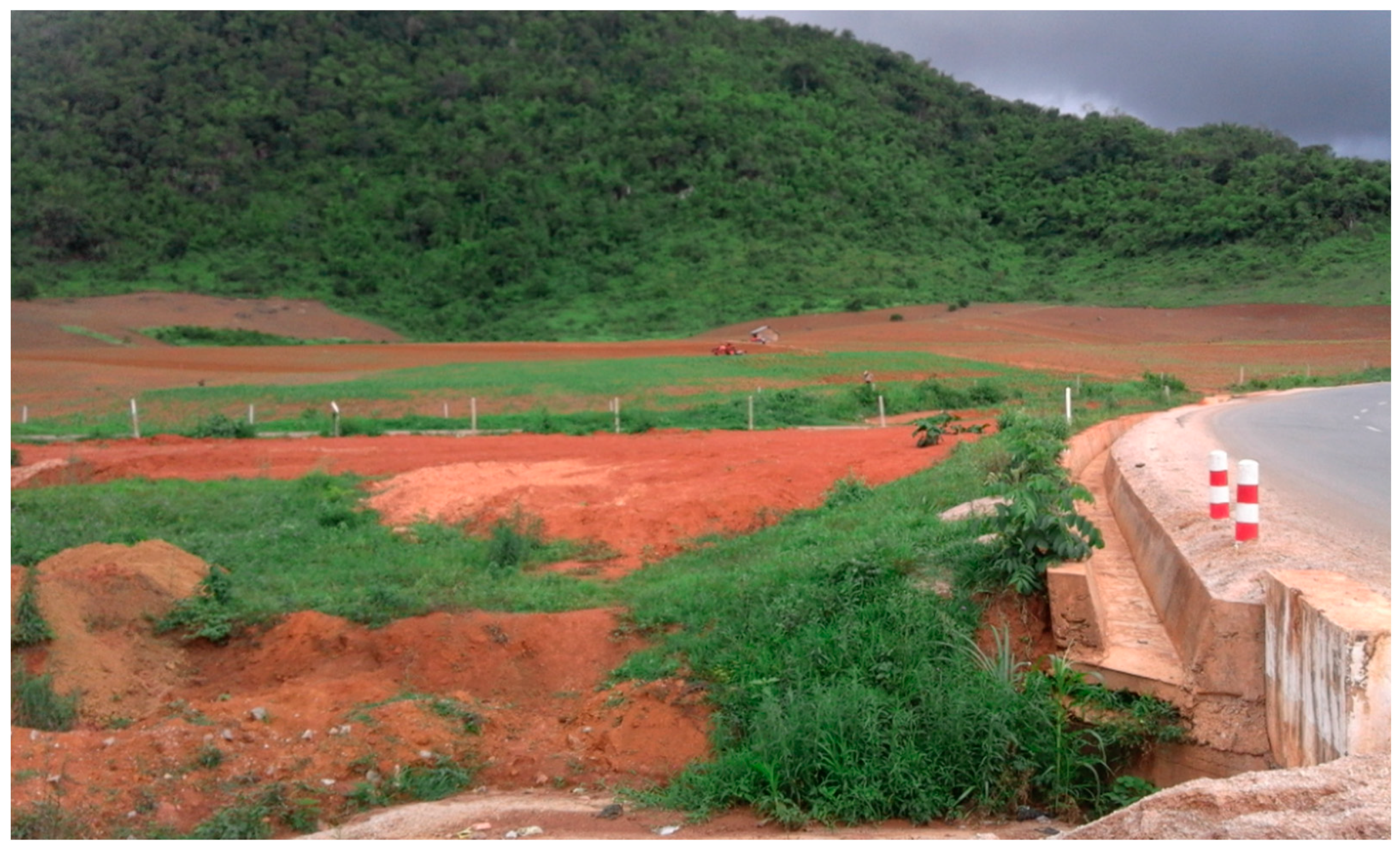
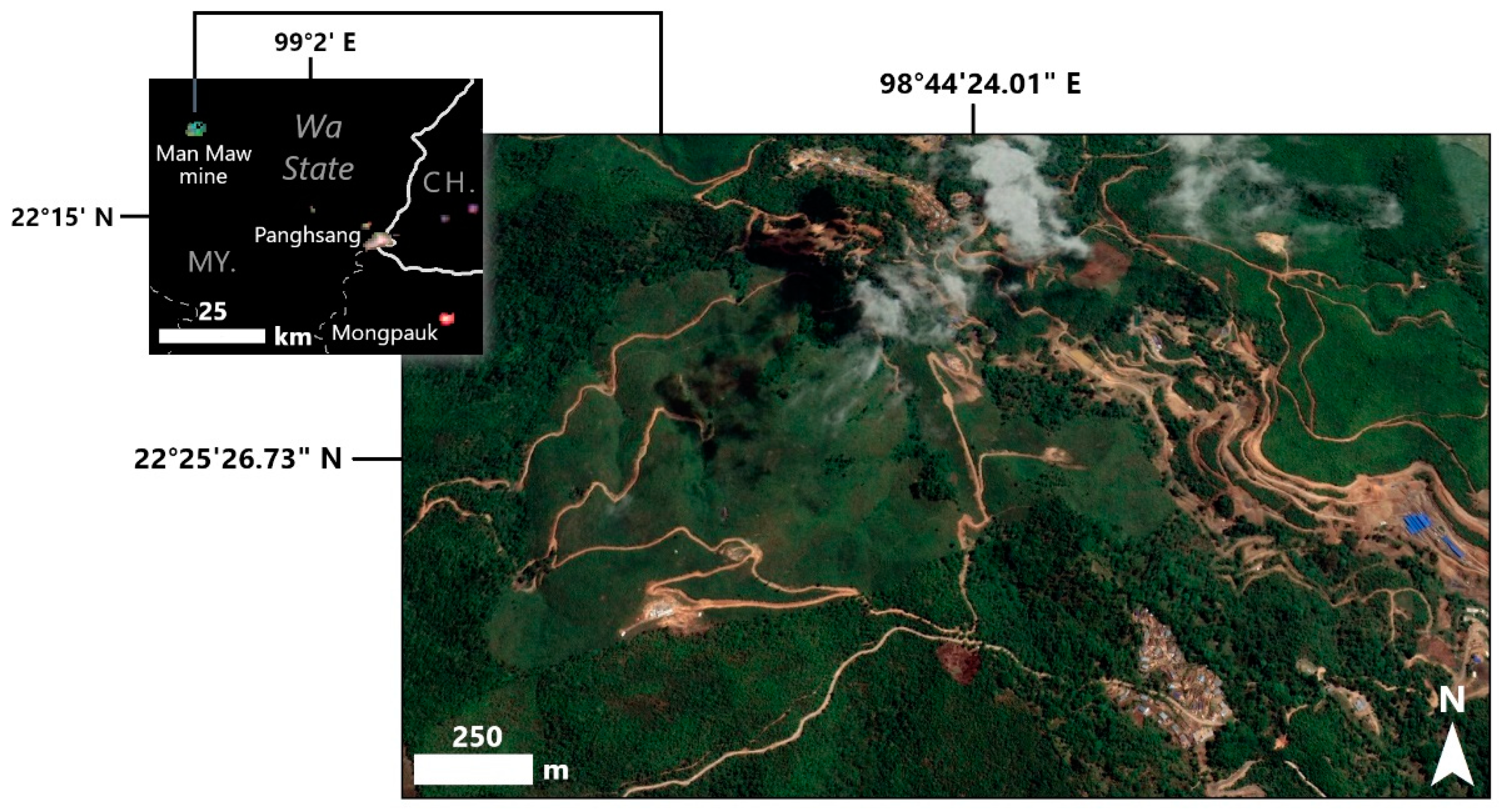
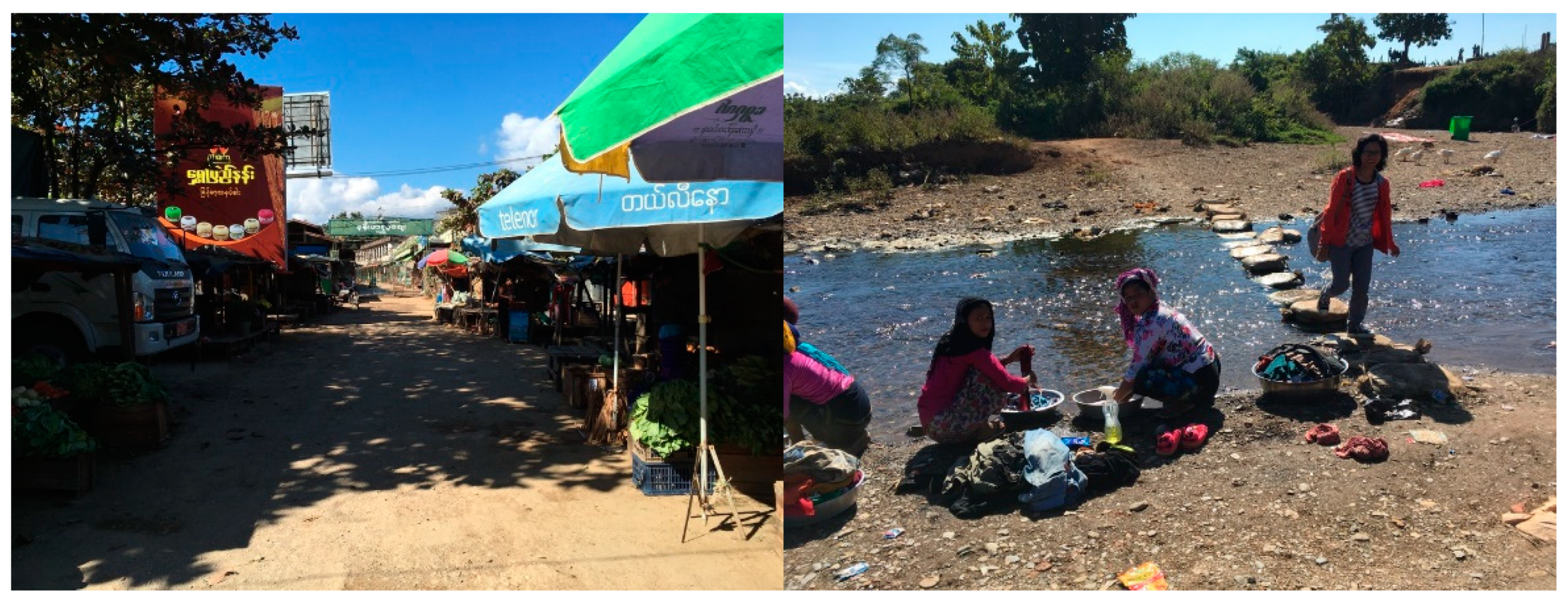

| Name | Division Type | Annual Rate of Change in DN (1992–2013) | Annual Rate of Change in Radiance (2013–2020) | nW·cm−2·sr−1/km2 (2020) |
|---|---|---|---|---|
| Ayeyarwady | Region | 8.0% | 16.5% | 0.20 |
| Bago | Region | 10.0% | 11.7% | 0.31 |
| Chin | State | 0.4% | 60.7% | 0.01 |
| Kachin | State | 12.9% | 16.9% | 0.05 |
| Kayah | State | 7.7% | 20.6% | 0.13 |
| Kayin | State | 14.6% | 18.5% | 0.09 |
| Magway | Region | 3.5% | 12.9% | 0.22 |
| Mandalay | Region | 9.0% | 16.3% | 1.16 |
| Mon | State | 11.0% | 18.2% | 0.60 |
| Naypyitaw | Union territory | 21.3% | −4.5% | 2.02 |
| Rakhine | State | 5.5% | 29.0% | 0.07 |
| Sagaing | Region | 8.4% | 19.2% | 0.16 |
| Shan | State | 13.6% | 15.0% | 0.11 |
| Tanintharyi | Region | 8.4% | 22.2% | 0.07 |
| Yangon | Region | 5.8% | 10.8% | 3.87 |
| All regions | 7.6% | 15.6% | 0.85 | |
| All states | 9.4% | 25.6% | 0.15 |
Publisher’s Note: MDPI stays neutral with regard to jurisdictional claims in published maps and institutional affiliations. |
© 2021 by the authors. Licensee MDPI, Basel, Switzerland. This article is an open access article distributed under the terms and conditions of the Creative Commons Attribution (CC BY) license (http://creativecommons.org/licenses/by/4.0/).
Share and Cite
Bennett, M.M.; Faxon, H.O. Uneven Frontiers: Exposing the Geopolitics of Myanmar’s Borderlands with Critical Remote Sensing. Remote Sens. 2021, 13, 1158. https://doi.org/10.3390/rs13061158
Bennett MM, Faxon HO. Uneven Frontiers: Exposing the Geopolitics of Myanmar’s Borderlands with Critical Remote Sensing. Remote Sensing. 2021; 13(6):1158. https://doi.org/10.3390/rs13061158
Chicago/Turabian StyleBennett, Mia M., and Hilary Oliva Faxon. 2021. "Uneven Frontiers: Exposing the Geopolitics of Myanmar’s Borderlands with Critical Remote Sensing" Remote Sensing 13, no. 6: 1158. https://doi.org/10.3390/rs13061158
APA StyleBennett, M. M., & Faxon, H. O. (2021). Uneven Frontiers: Exposing the Geopolitics of Myanmar’s Borderlands with Critical Remote Sensing. Remote Sensing, 13(6), 1158. https://doi.org/10.3390/rs13061158





